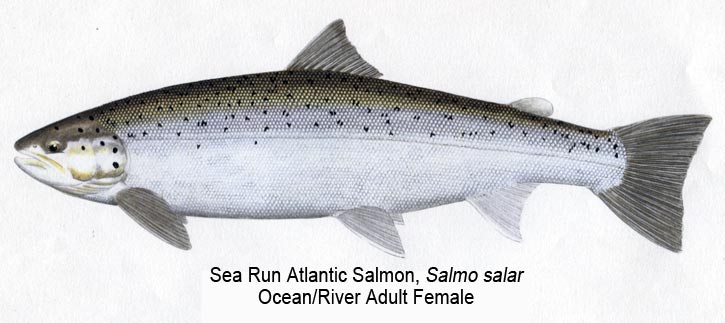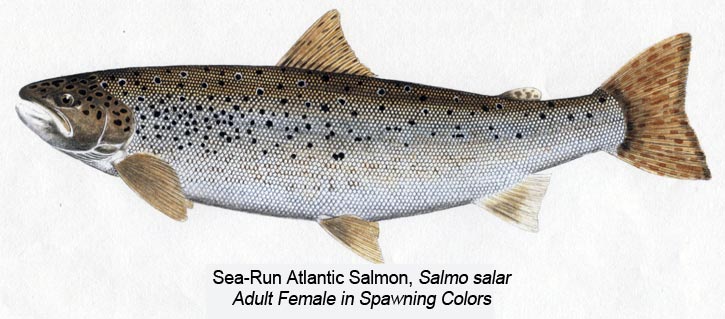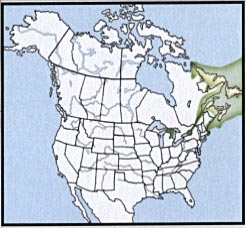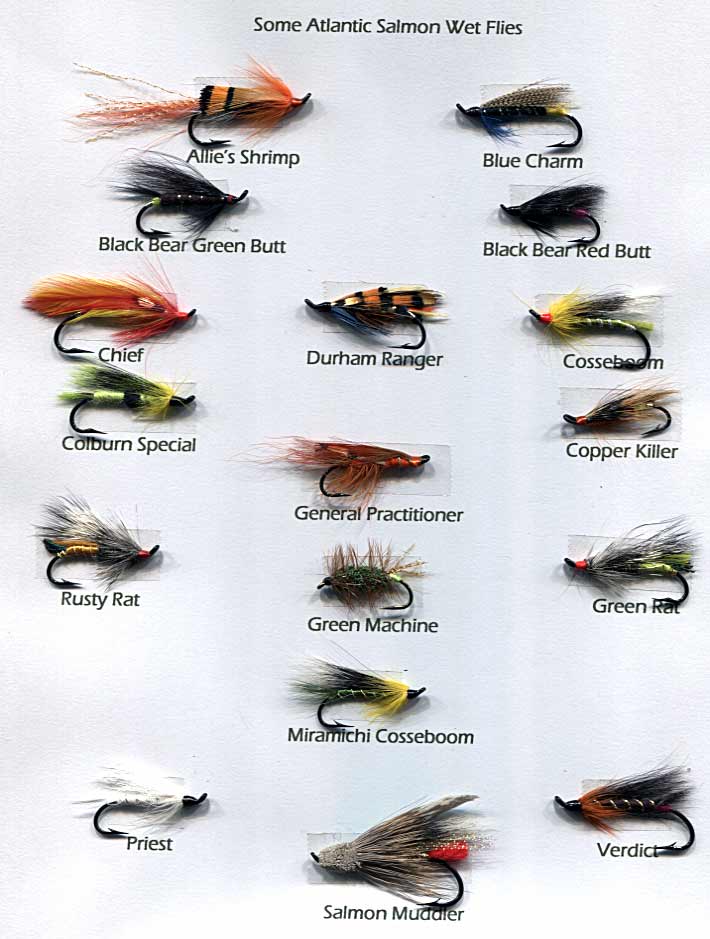Atlantic Salmon, June 2012, Fish of the Month!



Atlantic Salmon (Sea-run)
Salmo salar
Local Names:
Salmon, Sea Salmon, Grayling, Spring salmon, Bay salmon
Average Size:
24 to 32 inches
6 to 15 pounds
Distinguishing Field Marks:
Color and color pattern are reliable distinguishing field marks for this species. (See the illustration.)
-
The gums and inside of the mouth are white.
-
The mouth is smaller than in other salmon and trout. The upper jaw does not extend beyond the rear edge of the eye.
-
The caudal peduncle is slender, making it easy to hold an Atlantic salmon by the base of its tail.
-
The anal fin is short-based and nearly triangular in shape, with 8 to 11 principle rays.

-
In fresh-run fish, there are few, if any, spots on any of the fins, including the tail. Their backs are lightly sprinkled with small, dark, or black, usually X-shaped spots. There are usually only a few spots on the head and gill covers.
-
In the spawning season, male Atlantic salmon develop very elongated upper and lower jaws, known as the "kype."
-
In spawning season, both males and females become much more heavily spotted and darkly colored. (See illustrations)
-
Young Atlantic salmon (parr and smolts) have moderately forked tails. As they age, the trailing edge of the tail becomes straighter, more squared.
North American Range:
Map to the right shows approximate range in North America.
Diet:
Newly hatched Atlantic salmon fry feed on planktonic organisms carried to them on the stream's current. At the parr stage, they feed almost exclusively on immature and adult aquatic insects. When at sea, adult Atlantic salmon feed on small fishes, especially Capelin, shrimps, and squid.
Locating and Fly Fishing for Atlantic Salmon:
Because their fresh-water range was never very large, and has been rather severely depleted in the last 100 years, finding Atlantic salmon is not much of a problem. There just aren't that many rivers that support fishable runs these days. This is true on both sides of the Atlantic. On this side, Atlantic Canada has the most reliable runs. I'm going to "stick my neck out" here and write that probably the Miramichi watershed in New Brunswick, Canada still holds the "mother-lode." I'm sure that some readers of this will disagree, favoring their home rivers instead. So be it. Keep the cards and letters coming. We're always glad to hear good news.
A couple of hundred years ago, this species was so abundant that laws were passed prohibiting employers of seasonal agricultural workers the serving of salmon to their help more than three meals a week. In those days, ten-boat chains of salmon-filled Grand Banks dories would haul their catch to fish market suppliers up and down the east coast. Sadly, those days are long gone, probably never to return. The Atlantic salmon's demise was/is a precursor of what we are now witnessing with our Pacific salmon and Steelhead runs. 
If you decide that you must at least try to connect with a sea-run Atlantic salmon, choose a river, contact a reliable information source on that river, and be prepared to put out some serious cash for the opportunity; "opportunity" being the key word there. Last fall I was in a freighter canoe on a large pool on the midsection of the Main Southwest Miramichi River watching what must have been close to 1,000 salmon of all sizes rolling, jumping, tailing, swirling, all around us. In that sentence, "watching" is the key word, because, after showing what both my guide (who's poled and paddled every river in New Brunswick and southeastern Quebec Provinces, and probably was on a first-name basis with all those fish) and I thought were the flies most likely to irritate one of those fish into striking, I put my rod down and just enjoyed the show……..If your idea of a successful fly fishing trip is based on numbers of fish caught? Stay home, stick with Bluegills. I don't care how much you spend to get there, stay there, hire a guide, eat there, and fish there, what happens on an Atlantic salmon river is up to the salmon, not you. But, what a "religious experience" it is. Humans have justifiably idolized these magnificent game (and food) fish for literally thousands of years. Coming from a major Lake Ontario tributary where the annual influx of blood-thirsty Chinook salmon "anglers" with their bottom-feeding attitudes and practices have caused hundreds of ethical anglers to simply stop fishing there, I feel like I've died and gone to heaven on the Miramichi. It's as if the whole watershed is a huge cathedral dedicated to a deep reverence for the rivers and the fish. I gotta tell ya folks, I like that.
Now, you need some Atlantic salmon gear, right? In North America? Atlantis salmon fishing is fly fishing only…….Think 9 (still probably the most popular) to 11 foot rods for 7/8/9 weight lines. My preference (thanks, Ron) is for my beloved Hook & Hackle, Rainshadow 10' 8" 8 weight rod, with a Redington 7/8/9 Surge reel (You don't have to re-mortgage your house to get a good fly reel today, although, you can if you want to.) loaded with a weight forward 8 or a H&H Switch 101 400 grain line. Your 9 to 12 foot leaders should be tapered according to your preference and end with no less than a 6 lb. tippet section, the shorter, heavier leaders for higher water, the longer finer ones for low, clear water. The increasingly popular Spey rod is so named because it was birthed on Scotland's Spey River, a wide, shallow stream that requires long casts. They seem to be all the rage, so, if you're into the current fly-fishing fashions, you may feel you need to have one. For me? Ten to eleven foot "switch" rods are ideal for Atlantic salmon and Steelhead fishing. I can cast them with either one or two hands. They're long enough to make long, easy roll casts, and mend line like champs, and, all this without wearing me down, allowing only two handed casting, or making it nearly impossible to unhook and release a fish without someone else's assistance. (Try getting a good hold on a large fish that's held at the tip of your Spey rod some 14 feet away from you (by yourself.).)
Oh yeah, unlike Pacific salmon and Steelhead, you don't usually need to bounce bottom to irritate an Atlantic salmon into taking your fly. In fact, I believe that What or Whomever designed this blue-green planet of ours had fly-fishers in mind when the idea for these fish came in. Atlantics (when they want to) love to chase flies, wet or dry. You may find that having left all your sink-tip lines at home was not the best idea, as on some days, mainly with fish that have been in the river for an extended period, you do need to get your fly in their faces.
The flies, ahhhhh yes, the flies…..Probably there are more books, both in and out of print, focusing on trout flies than on Atlantic salmon flies, but, not, I think, all that many. Volumes and volumes dedicated to this fish and the flies made to entice it to take have been written, lavishly illustrated, and published. I've included a scan of just a few of the basic, most often used, Atlantic salmon fly patterns. As with other game fish species, regulars on any salmon river have developed their own fly patterns and variations of fly patterns. Perhaps more so with Atlantic salmon than most other species, pay attention to what flies your guide suggests you use on his river. And, by the way, Atlantic salmon flies are the patterns from which all the early generations of Steelhead flies were developed.
Once you’ve put your gear package together, got to the river, got licensed, enjoyed a relaxing breakfast, and you and your guide are on the water, if the river goddess likes everything you’ve done and are doing, a chrome bright 14 lb. salmon may take your swinging #6 Green Rat into the corner of her mouth, head back to her lie, feel the pull of your rod on the fly, get the picture that something is not quite right and decide that the way to correct that problem is to run at freight-train speed away from the pull, punctuate the end of that first 25 yard run with a couple of end-over-end high jumps, and all that in a matter of about 30 seconds, you’ll probably be thinking, “I like this, yup, I like this.” That’s called getting “Salmonized,” and it’s one of life’s peak experiences; and yes, it is highly addictive!!!
Folks, please, if you do get a salmon to hand, carefully release it so it can make babies. Not all that long ago, those in the know were gravely concerned that this great fish would soon go the way of the Dodo bird and the Passener pigeon. Happily, that has not been the case. There has been something of a resurgence of Atlantic salmon numbers in some rivers in the last say 10 years. Other streams, that historically hosted healthy, vibrant, self-sustaining runs, are still fishless today. Whatever Atlantic salmon river you choose to fish will have a specific litany of rules and regulations. Your home waters may be places where the "game warden" is hardly ever seen? On Atlantic salmon rivers? Don't even think about bending or breaking the local or provincial rules, especially access and water rights rules. Every two anglers have a guide with them. Those guides make their living from the fish and the river, they are the "eyes of the law," and your best source of good information on that water. Show respect for the rivers' entire ambiance, and you'll get respect from it in return. It wouldn't hurt to bring some of that home to share with your fishing pals either.
One last word on Atlantic salmon fishing: Keep your fly in the water.






